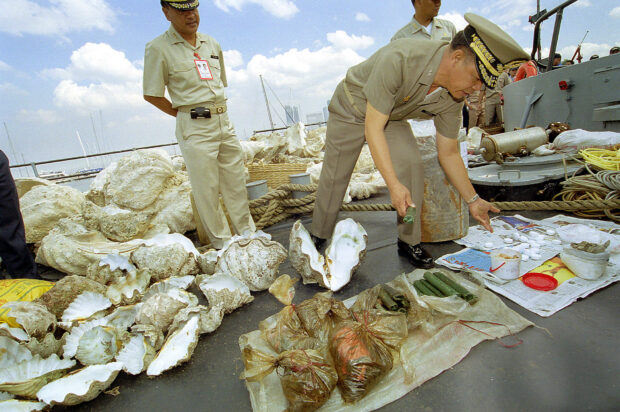China island-building, fishing caused most reef damage in SCS, says study

ILLEGAL HARVEST Philippine Navy officials inspect giant clams, several pieces of dynamite and some cyanide seized from Chinese fishermen apprehended at Panatag (Scarborough) Shoal, in this March 2001 Inquirer file photo. —ERIK ARAZAS
China’s island-building activities for military outposts in the South China Sea (SCS) have been responsible for the destruction of around 19 square kilometers of coral reefs, according to a recent study.
Chinese fishermen, meanwhile, have damaged an additional 67 sq km, mainly in their search for giant clams, the Asia Maritime Transparency Initiative (Amti) said in a report.
“In recent decades, increased fishing, dredging and landfill, along with giant clam harvesting, have taken a devastating toll on thousands of species found nowhere else on earth,” Amti said in a study titled “Deep Blue Scars: Environmental Threats to the South China Sea.”
READ: China envoy summoned over ‘aggression’ in West Philippine Sea
Amti is a project of the Center for Strategic and International Studies, a think tank based in Washington. Released on Dec. 18 last year, the report is authored by maritime experts Monica Sato (a Filipino based in Washington), Harrison Pretat, Tabitha Mallory, Hao Chen and Gregory Poling.
The report also cited the damage attributed to other countries with overlapping territorial claims in the South China Sea, such as Vietnam, Malaysia, Brunei and the Philippines. But it found China to have made the heaviest impact—or being responsible for 75 percent of the damage—due to its use of heavy equipment and drastic methods that disturb the seabed on a large scale.
Warning on Vietnam
“Its cutter suction dredgers would slice into the reef and pump sediment through floating pipelines to shallow areas to deposit it as landfill. This process disturbed the seafloor, creating clouds of abrasive sediment that killed nearby marine life and overwhelmed the coral reef’s capacity to repair itself,” the report said.
Both China and Vietnam were noted for extracting corals and clams, and catching fish and crabs through bottom-trawling.
Vietnam, the report said, had also engaged in reclamation activities, used clamshell dredgers and scooped up reefs for landfills using construction equipment, but its slower methods caused less collateral damage.
“More recently, however, Vietnam has turned to cutter suction dredgers like China’s. This large-scale expansion of Vietnam’s South China Sea outposts remains ongoing and will have major consequences for the surrounding marine environment,” it said.
“The harvesting of giant clams for their remarkable shells has become popular in recent decades because of their resemblance to elephant ivory, which is now extremely difficult or illegal to obtain.”
‘Arc-shaped scars’
The prized clams, it noted, are typically used in jewelry and sculpture, and the carved shells can fetch as much as $106,000 apiece.“In satellite imagery of the South China Sea, many reefs show arc-shaped scars, which are created when fishers dig up reef surfaces by dragging specially made brass propellers in a semicircle around the anchor chain on the front of their boats,” Amti said.
The report also quoted Philippine sources, mainly the Western Command of the Armed Forces of the Philippines, which in September last year blamed Chinese fishing vessels for the severe damage on coral reefs in the Rozul (Iroquois) Reef and Escoda (Sabina) Shoals.
READ: PH to China: Respect, sincerity are key to sea row dialogue
To press its claim to practically all of the South China Sea, Beijing has been building artificial islands since the mid-2010s, first claiming they would serve as shelters for fishermen but eventually developing them for military use, like in the case of the Kagitingan (Fiery Cross), Zamora (Subi) and Panganiban (Mischief) Reefs.
While the Philippines, Malaysia and Taiwan have also developed maritime features to assert their claims, their efforts were not as massive as China’s and Vietnam’s, and steps were taken to minimize their environmental impact, the report added.
Beijing continues to ignore the 2016 international arbitration ruling that invalidated its so-called nine-dash claim in the South China Sea and upheld Manila’s sovereign rights and jurisdiction over its 370-kilometer exclusive economic zone.
For comprehensive coverage, in-depth analysis, visit our special page for West Philippine Sea updates. Stay informed with articles, videos, and expert opinions.